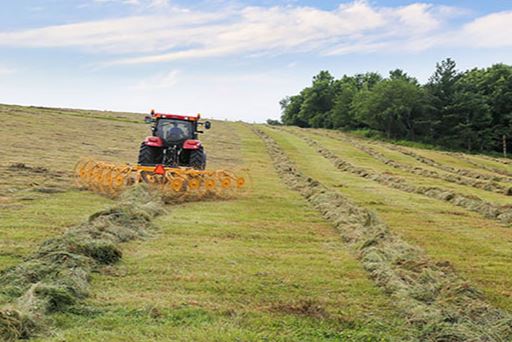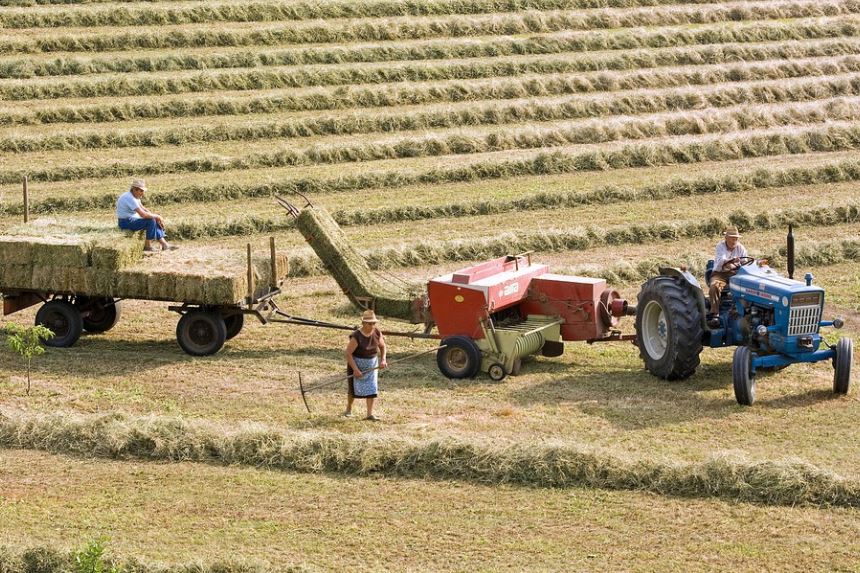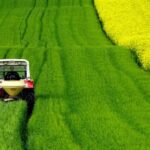We hear you wonder what’s the best hay rake for your operation. While you may think a hay rake is just a hay rake, this is not true. There are different hay rakes, each with specific features and functions. The reason why today we’ll be sharing with you everything you need to know about the hay rake, you may also find a hay wagon quite useful.
The hay rake can have a significant influence on your forage crop. These machines may not receive proper credit but are essential to producing high-quality forage. Choosing a hay rake for your farm operation can seem like a challenging task.
The choices for hay rakes are many in the market. But before you make any investments, keep scrolling down to learn what you need to know about the different types of hay rake and which would be best for your pocket and your hay production needs.
Hay Rake FAQ’s
What is a Hay Rake?
A hay rake rakes hay into windrows which are lines of hay that a baler can more easily pick up. It is a common misconception that hay can be baled directly from the swath created by the hay mower.
What is the purpose of a hay rake?
A hay rake is an agricultural rake used to collect cut hay or straw into windrows for later collection. It is also designed to fluff up the hay and turn it over to dry. It is also used in the evening to protect the hay from morning dew.
What is the difference between a hay rake and a Tedder?
Tedders cause more leaf loss than rakes, especially in alfalfa hay, which partially dry. However, tedders allow for a quicker drying rate because of the wide swath in which the hay is placed.
Which hay rake is best?
Models like the Vermeer R2800 twin rake are consequently better able to handle wetter, heavier forage crops in addition to performing well in dry hay. Because teeth don’t come into contact with the ground, parallel bar rakes offer overall durability and ease of maintenance similar to wheel rakes.
When should hay be raked?
As a rule of thumb, wait to rake hay until after the dew has dried and the sun nears its peak, around 11 a.m. If possible, let the raked hay sit for an hour or two before baling to allow more drying time. Haymakers have several types of rakes available.
What is the best way to rake hayfield?
First, rake a pass toward the edge on your back and forth rows, leaving a hay rake width of unraked hay. Make a left-hand U-turn at the end of the row to double up the row. When you get to the other end, turn left, skip a hay rake width, and start over.
What are the different styles of hay rake?
The four most prominent styles of hay rakes are:
Wheel Rake
These rakes are built for speed and productivity when handling dry hay. Wheel rakes are simple machines that require minimal adjustments for proper operation. The economical ground drive simplifies operation and reduces cost. However, its direct contact with the ground can cause dirt and stones to be introduced into the hay, decreasing overall quality.
Parallel Bar Rakes
Called by many different names in different regions of the US, these machines are relatively simple, with a design that dates back over 100 years. Rotary rakes and belt rakes are similarly priced and have additional benefits, such as the ability to produce fluffy windrows in all crop conditions. Wheel rakes are a more economical choice and offer similar raking quality to parallel bar rakes.
Rotary Rakes
These powered rakes create a uniform and fluffy windrow, which allows crops to dry faster. The gentle rotary-raking action minimizes leaf loss and provides a more uniform windrow for better bale formation. These rakes are capable of handling both wet forage and dry hay, giving them greater versatility than wheel rakes. A rotary rake’s mechanical drive enables it to move heavy, wet crops. It also keeps the tines from contacting the ground, minimizing the amount of contamination raked into the harvest. This results in higher-quality feed.
Belt Rakes
Belt rakes, also called power rakes, have all the advantages of a rotary rake. They can handle both wet and dry forage; they make a fluffy, consistent windrow; the tines do not touch the ground, reducing contamination of the forage; and they come in a wide variety of sizes.
Hay Rake Types
VR2040 HIGH-CAPACITY WHEEL RAKE
The VR2040 high-capacity wheel rake has a 40-ft (12.2-m) raking width and a unique wheel suspension system that offers maximum efficiency and raking power.
Now you can cover more acres in less time; and with minimal maintenance with the rugged VR2040 high-capacity wheel rake.
You can count with a dual-purpose lift and suspension cylinder on each rake wheel coupled with a nitrogen-charged accumulator for quickly changing rake wheel settings and pressure.

Features:
- One-piece rake arms
- Wide range of motion
- Easily adjustable rake wheel settings
R2800 TWIN RAKE
It all starts with the Vermeer R2800 twin rake, which produces box-shaped windrows. Built to last, the R2800 allows you to adjust the width of the windows to match your baler.
Control the width, basket lift, and folding/unfolding systems right from the cab of your tractor.
Keep hay clean because the hydraulically driven baskets have rubber-mounted rake teeth that engage the crop, not the ground.

Features:
- Large, caster-type wheels
- Hydraulic basket lift
- Rubber-mounted rake teeth
VR1022 CARTED WHEEL RAKE
When you’re making hay, you need the reliability, strength, and high-performance capability of the VR1022 carted wheel rake.
Featuring several Vermeer innovations, the VR1022 is easy to operate and build high-volume raking.
Take on each field with adjustable hitch heights and telescoping toolbars that allow you to change raking and windrow widths easily. Patented rubber torsion toolbar suspension requires no tools.

Features:
- Five wheels per wing
- High-clearance frame
- Greaseable tapered roller bearings
VR1428 HIGH-CAPACITY WHEEL RAKE
The heavy-duty VR1428 high-capacity wheel rake is capable of raking 28 ft (8.5 m) wide in one pass – yet nimble enough to maneuver like rakes much smaller in size.
It offers producers more capacity and the ability to handle more acres in less time, with fewer maintenance issues by combining rugged construction, intelligent, streamlined design, and functionality with simple, tool-free adjustments.

Features:
- The optional center splitter attachment
- Heavy-duty construction
- Easily adjustable rake wheel



